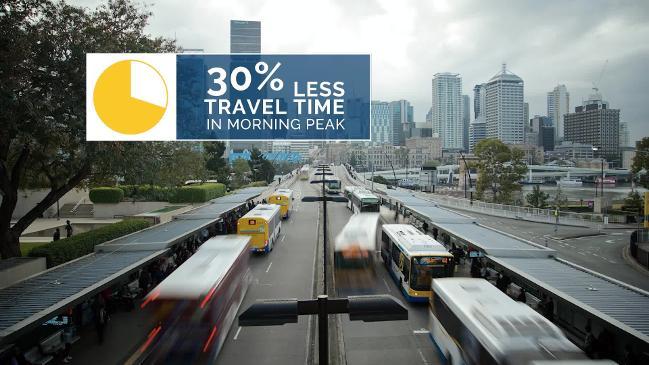Brisbane’s mega $20b Metro network just the start
A PLANNED $20 billion expansion of the Brisbane Metro will quadruple the public transport network by 2043. SEE FULL METRO MAP

QLD News
Don't miss out on the headlines from QLD News. Followed categories will be added to My News.
A PLANNED $20 billion expansion of the Brisbane Metro would quadruple the public transport network by 2043.
Work on stage one of the Metro is underway with services — from Eight Mile Plains to Roma St, and the University of Queensland to the Royal Brisbane and Women’s Hospital — to be up and running in 2023, followed a year later by the State Government’s Cross River Rail system.
Crucial as they are, Brisbane Deputy Mayor Adrian Schrinner said the projects were just the start of addressing the region’s public transport needs.
“The critical thing is to have a pipeline of projects beyond (those),” he said.
“The planning needs to be done for the next round before Metro and Cross River Rail are completed. We need to move seamlessly from those projects into the next round.”
The Courier-Mail’s Future SEQ series is examining transport infrastructure as part of developing an action plan for the region’s effective growth over the next quarter-century to ensure liveability and prosperity. It will culminate in a major event on October 23.

“The way Metro has been designed is that it’s an expandable model. The first two metro lines are just stage one and there will be stages 2, 3, 4 and 5. A network of Metro lines across the city is something we should be aspiring to,” Cr Schrinner said.
Future expansions are likely to take the system to Bracken Ridge in the north, Springwood in the south, Capalaba in the east and, possibly, Kenmore and the Centenary suburbs in the west.
“Within that 25-year period we should be looking at all those options, absolutely,” Cr Schrinner said.
MISSING LINK FOR TRANSPORT SYSTEM
WHY DRIVERS WON’T MAKE THE SWITCH
$70b PLAN TO CUT COMMUTE TIMES
They would add 62km to the 21km of existing busways being repurposed for the first two lines for the high-frequency (every three minutes peak hour, five minutes rest of the day) Metro system.
“While it’s a $1 billion project, if the entire two Metro lines were delivered from scratch, I’d say it would be around a $10 billion project,” Cr Schrinner said.
“So future extensions, we’re looking $10 to $20 billion worth of work.”

The expansion of Metro would depend on the construction of new busways by the State Government.
The State Infrastructure Plan includes the extensions to Bracken Ridge, Capalaba and Springwood. Transitways offering dedicated bus lanes to Chermside and Carindale are planned as “medium-term’’ solutions. Design will start in the coming weeks on the dedicated 2.3km bus corridor between Kedron and Chermside.
Attracting private sector investment through development opportunities around new stations would be important, Cr Schrinner said, but borrowing to build vital infrastructure was “perfectly reasonable and justifiable”.
Initial Metro services will operate 20 hours a day, five days a week and all night Friday and Saturdays.
Cr Schrinner said that by 2043, citywide 24/7 public transport will be the norm.
Buses and local shuttles, possibly operated by rideshare companies, will connect into mass transit such as Metro and train stations. They will be driverless within 10 to 15 years and will change their routes according to demand registered digitally.

“Just imagine you open up your app to find a journey to the city, the app knows where you are and where you want to go and then can start dynamically re-routing some hail and ride vehicles into your area,” he said.
“This technology already exists now.
“You may have to take several different modes for travel but it will be delivered in a way that’s convenient for people. People are prepared to make those transfers between modes if there is a time-saving or another benefit such as not having the stress of sitting in traffic.”
Commuter Rebecca Topp, who catches the bus into the city from The Gap, said she hoped to see more buses serving the suburbs.
Cross River Rail — including a 10.2km rail line between Dutton Park and Bowen Hills, with a tunnel under the Brisbane River and four new underground stations at Boggo Rd, Woolloongabba, Albert St and Roma St — will raise the rail system capacity from 66 trains an hour during the morning peak now to 106 by 2036.
Transport Minister Mark Bailey said the new river crossing was the essential catalyst to enable expansions of the rail system in the future.
The latest rail strategy is currently being prepared. Mr Bailey said priorities included duplication of the Sunshine Coast line from Beerburrum to Nambour and a new spur to Maroochydore; a new line from Salisbury to the new 120,000-resident development at Greater Flagstone and Beaudesert; extending the Springfield line to Redbank Plains, Ripley and then on to Ipswich; extending the Gold Coast line to the airport and completing the Gold Coast light rail to the airport.

Corridors have been protected for the lines from Varsity Lakes to Gold Coast Airport, Beerwah to Maroochydore and Caloundra, the stretch of the Springfield line between Augustine Heights and Ipswich, and the light rail extension. Planning to protect the other corridors is underway.
But none of the projects have any funding.
The Minister said the idea of a regional rapid rail network proposed by the SEQ Council of Mayors this week was appealing, “but it comes with a big price tag. It has to stack up economically.”
A report by professional services firm PwC for the Future SEQ series suggests the optimal public transport system for large cities is a series of circular routes, rather than a model which funnels people into a CBD.
“Brisbane and SEQ do not yet have sufficient critical mass to make such a system feasible,” the report said.
“However, consideration must be given now for increased population in 2043, and if employment will be decentralised in the form of a series of nodes across SEQ.”
Rail Back on Track spokesman Robert Dow calls for an “outer circle railway’’ between Cleveland, Beenleigh and Ipswich to service high-growth areas. Growth on the privately-operated Airtrain would also see a need for duplication on that line.
Originally published as Brisbane’s mega $20b Metro network just the start


